Lesson 20: Sore/Sono/Sonna/Sou etc. how directional words REALLY work!”
こんにちは。
Today we’re going to talk about the Japanese system of directional words which use
こ-, そ-, あ-, ど-.
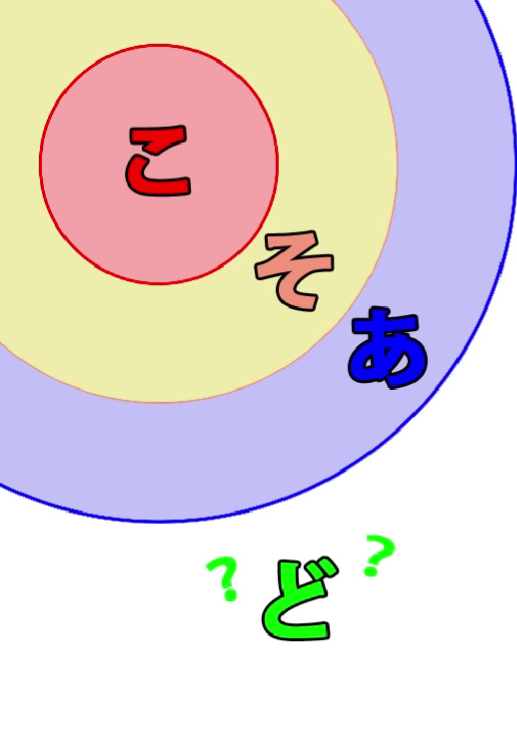
This is commonly called the こ-そ-あ-ど system and initially it simply marks physical locations, but it then expands out to more subtle and metaphorical uses.
This is common because all languages use physical metaphors to express abstract concepts.
And fortunately these means of expression are often similar across languages because
the conceptual world maps to the physical world in certain quite predictable ways.
So let’s take the most basic meaning and use of こ-そ-あ-ど, and that is actual physical locations.
ここ, そこ, あそこ, どこ
The most basic location use is ここ, そこ, あそこ, どこ.
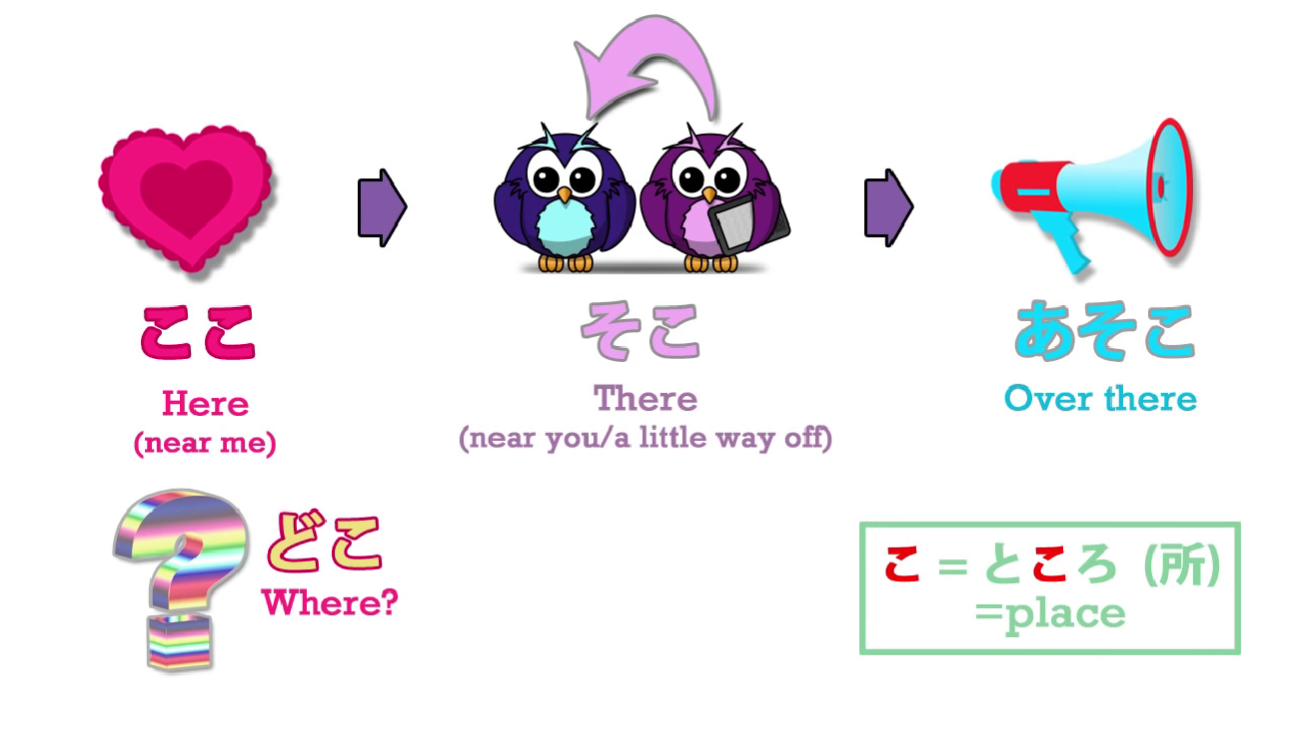
ここ means here.
If you know the Japanese word こころ/心 - heart - it’s here, right where I am, right where my heart is. That’s not the etymology of the word, but it’s a mnemonic.
そこ means there.
Now, often ここ means the speaker’s place and そこ means the place of the listener.
あそこ means over there
and it often means distant from both the speaker and the listener.
So the あ word means over there, somewhat in the distance, so it’s a bit far away,
you have to aaaah - shout - to be heard over there.
どこ means where, so that’s a question word.
So, こ words mean here, possibly near to me,
the そ words mean there, often near to you,
the あ words mean over there,
and the ど words form a question.
So, in anime or manga you’ll often see someone saying,
ここはどこ? - Where is this?
Literally, Speaking of this place, where (is it)?
And that seems to be the most usual way for a Japanese person to ask that question finding
herself suddenly in an unknown location.
The English way of asking it is more likely to be ---- Where am I?
but the Japanese way is Where is this place?
ここはどこ? - As for this place, where?
Now, that’s quite simple, I think.
And now we’re going to look at something that does occasionally confuse people,
and that’s because when we come to the れ- and the の-group, in English we express both with the same word.
But we do have the distinction, so let’s look at those.
これ, それ, あれ, どれ

The れ-group is これ, それ, あれ, どれ.
And the thing here is that the -れ means a thing.
こ- means a place, a location, and it can actually be written with the kanji for 所 - place.
-れ is related to ある.

It’s one of these things that’s related to the fundamental ある, the mother of verbs.
And ある means to be; this -れ means a being.
When we say a being in English we usually mean a sentient being, an animal or a person
or something, but this means any kind of a being, anything that exists.
So, これ means this thing/this being;
それ means that thing/that being;
あれ means that thing over there/that being over there,
and どれ means which being/what thing?
この, その, あの, どの
Now, what these can get confused with is the の-group: この, その, あの, どの.

Now, -れ means a being and refers to a thing.
の, as we know, is used to make adjectivals or descriptors.
So if we say, さくらのドレス, we’re saying, Sakura’s dress.
If we say, でんせつのせんし/伝説の戦士, we’re saying, legendary warrior/warrior that belongs to the class of legend.
Now, this is the same の that we see in この/その/あの/どの.
So if we take a very basic textbook phrase like これは (zero が) ペンだ, we’re saying,
this - this being - (it) is a pen.
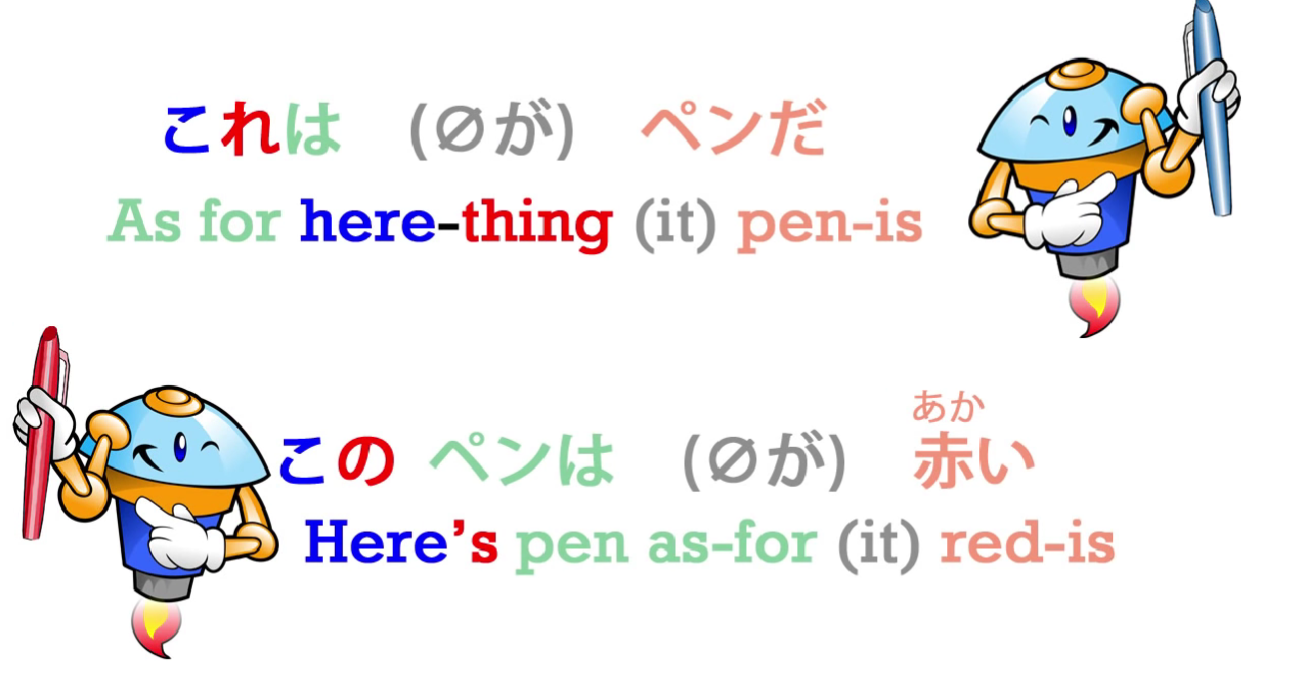
But if we say, このペン (zero が) は赤い - This pen (it) is red.
このペン - the here pen, the pen that belongs to the class of things that are here.

それは (zero が) ペンだ - That thing over there or the thing you’re holding (it) is a pen.
そのペンは (zero が) 赤い - That pen, the pen that belongs to the class of things over there, (it) is red.
Now, in English we can say this or this pen and there’s no distinction between the words.
We’re using this in both cases.
So, once we’ve got used to how they work, I think those are very straightforward too.
こんな, そんな, あんな, どんな
Now, the next group is こんな,そんな, あんな, どんな.
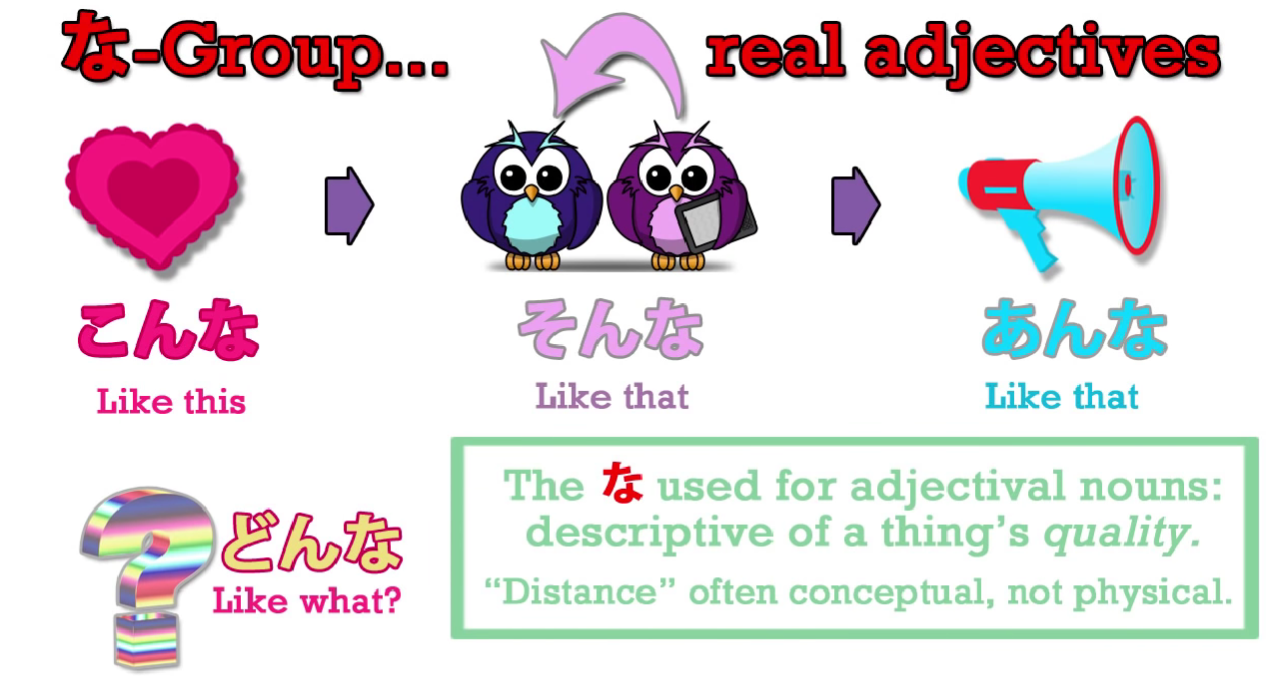
Now, in this case we are using -な.
And -な, as we know, is the form of the copula that turns an adjectival noun into an adjective that you can place before something else. (Lesson 6)
And this is exactly what’s happening here.
So, こんな means like this/this kind of;
そんな means that kind of,
あんな means that kind of over there/the further-away kind of.
And I’m not going to go into the details of this,
but whether we use そんな or あんなis going to depend on…
sometimes the literal position of something but very often on how far these things are from what we are talking about, from the present circumstance, from something we associate with ourselves.
So, we could say, こんな食べ物が好きです - I like food like this.
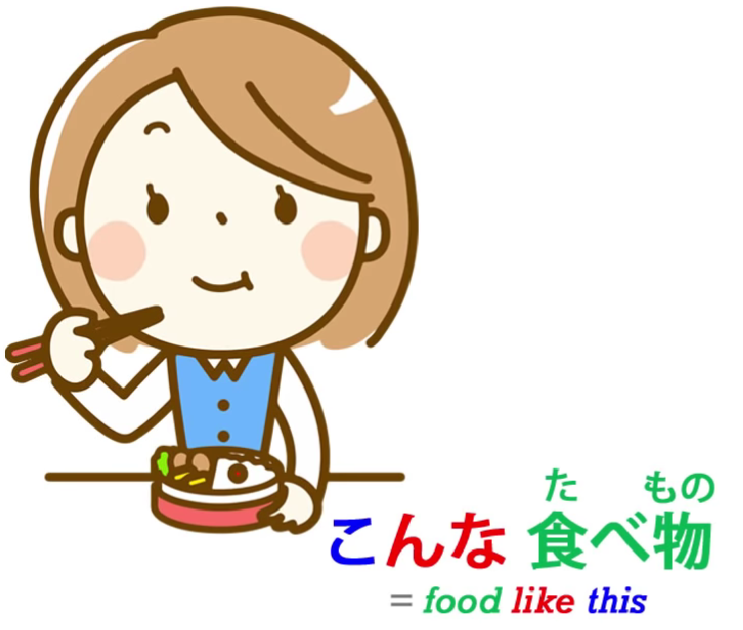
そんなことがひどい - That kind of thing’s unkind/cruel.

And in fact you’ll often find in anime or manga that someone just says, そんな!
And when it’s said in that kind of a complaining or accusing kind of way, it’s short for saying that kind of thing.
You’re saying, that kind of thing, and it would mean something like
that kind of thing is unkind/that kind of thing is mean / that kind of thing is something I don’t like.
そんな! - That you said such a thing!
So そんな is essentially a comparing adjectival:

we’re describing what something is like by comparing it to something else that we’re referring to, something that’s here, something that’s over there or something that’s way over there, either in physical space or conceptually.
どんな is asking what kind of a thing something is.
Literally, what would we compare it to?
こう, そう, ああ, どう

Now, when we use こ-そ-あ-ど on their own and lengthen them with -う
(or in the case of あ-, with an extra -あ) so they become こう, そう, ああ, どう,
then we are talking about the way something is or happens.
So when we say (zero が) そうですね? we’re saying, *(It)*That’s right, isn’t it?

So what we are really saying is (zero が) そうだ/そうです - (It) is like that.
If we say, そうする we mean do like that; if we say こうする we mean do like this:
do in that way/do in this way.
If we say どうする, we say do like how?
and we often say どうすればいい?

Now, すれば is the conditional form of する.
Saying どうすればいい? means how if I do will be good?
And we often find these combined with いう/言う meaning say.
It’s another example of the wider application of the concept of quotation in Japanese,
which we discussed recently.
And this is often used in relation to things that are not physical, concrete things -
in other words, the kind of things which we call こと rather than もの.
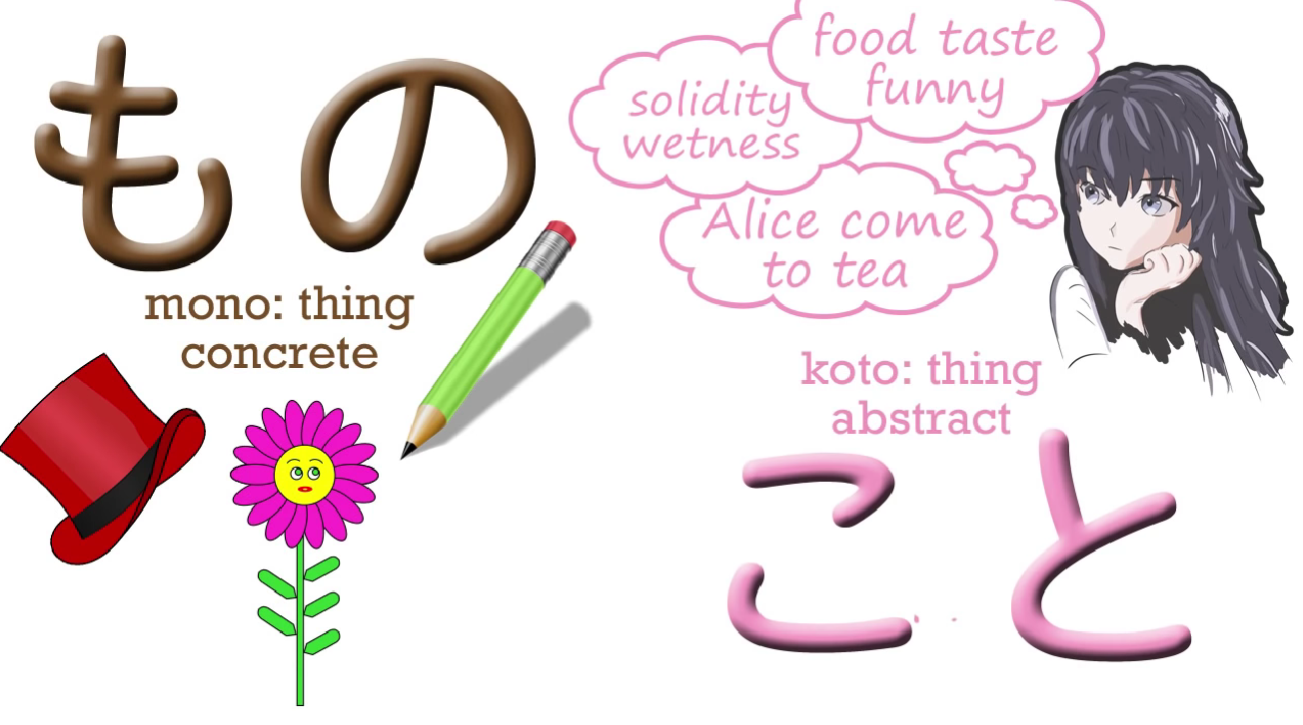
And we’re going to hear an awful lot そういうこと, こういうこと and どういうこと.
We also hear ああいうこと.
It’s less commonly used than the others, but it is used.
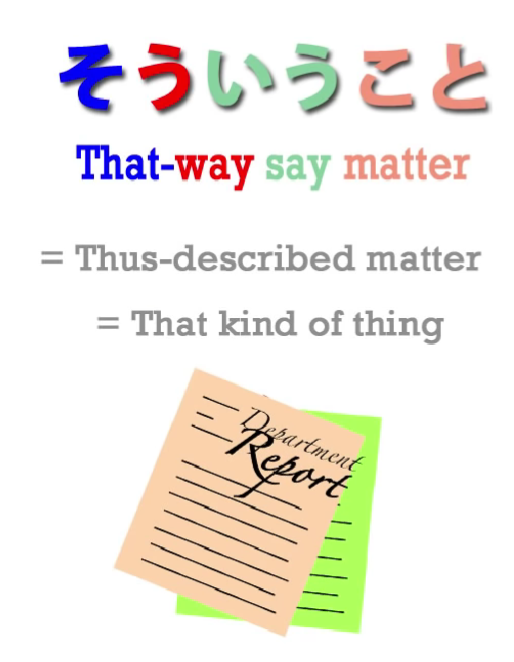
So what do we mean when we say
そういうこと - a thing of that kind;
こういうこと - a thing of this kind;
どういうこと - what kind of a thing?
Why do we mean what kind of a thing?
This kind of a thing / that kind of thing, what kind of a thing?
What we’re actually saying is
how-said thing / how-said circumstance / how-said condition.
In other words, in what way do we describe this condition / what kind of a description
does this circumstance or condition have?
And we often hear as a kind of exclamation, どういうこと!? and it means
what’s going on here? / what is this? / what description of thing is this that’s happening?
And it can also mean
what are you talking about / what are you getting at / what are you saying here?
どういうこと!?
And the thing to understand here is that
the いう there is not referring to the fact that the person has just said it.
どういうこと meaning What do you mean / what are you driving at / what are you talking about here?
The いう does not refer to the fact that you’re saying it.
The いう refers to the description of the thing.
So どういうこと is in this case short for
どういうことをいう? - how described thing are you saying?
So we see the こ-そ-あ-ど system works both in terms of literal location and in terms of metaphorical location.